Theobalds House
Theobalds House (also known as Theobalds Palace), located in what is now Cedars Park in the parish of Cheshunt in the English county of Hertfordshire, was a significant stately home and (later) royal palace of the 16th and early 17th centuries. Set in extensive parkland, it was a residence of statesmen Lord Burghley and his son, both leading royal advisers. James I enjoyed staying so much he acquired it from the Cecil family, further extending house and park. It was a notable example of the Elizabethan prodigy house, but was demolished as a result of the English Civil War.
| Theobalds House | |
|---|---|
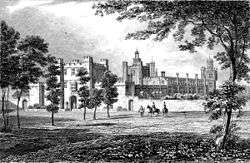 The Palace of Theobalds in the 17th century. Artist's impression. (This image is arguably Nonsuch Palace and incorrectly attributed as Theobalds) | |
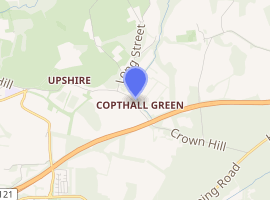
| |
| General information | |
| Coordinates | 51°41′20″N 0°3′22″E |
A new mansion was built in the Georgian era farther to the West: house and park were then acquired and the house extended by millionaire brewers the Meux family. London's Temple Bar Gate was preserved and stood in the park from 1880 to 2003, when it was moved back to London. The mansion is now part of a hotel and conference venue known as Theobalds Park; the house is a Grade II* listed building.[1][2]
Early history
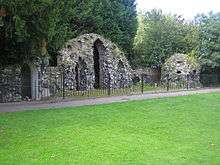
The manor was originally called Cullynges, later Tongs (after William de Tongge), and since 1440, Thebaudes, Tibbolds, and finally Theobalds. The original manor house was surrounded by a moat.[3] In 1563, it was bought by William Cecil, 1st Baron Burghley, senior councillor of Queen Elizabeth I. He entertained Elizabeth in this house on 27 July 1564.[4]
Lord Burghley commissioned a grand new house, which was built between 1564 and 1585. Burghley's intention in building the mansion was partly to demonstrate his increasingly dominant status at the Royal Court, and also to provide a palace fine enough to accommodate the Queen on her visits.[5] The Queen visited eight times, between 1572 and 1596. The location was ideal in that it lay just off the main road north from London to Ware, a 2.5 hour horse trot journey from London, and thus an ideal stop at the end of the first day of a royal tour. A list of rooms to be prepared for the royal visit in 1572 survives.[6]
The formal gardens of the house were modelled after the Château de Fontainebleau in France, the English botanist, John Gerard, acting as their superintendent. A plan for rebuilding the inner or conduit court in 1572 was made by Henry Hawthorne, who was a "purveyor" in the royal works.[7] In 1582 brass figures called "terms" were supplied for the Great Chamber fireplace and the windows were glazed with heraldry. There was a water feature, six artificial trees, and the ceiling was decorated with the signs of the zodiac. The great staircase with its oak carvings, similar those at Hatfield House, was salvaged and eventually installed at Herstmonceux Castle.[8] Another schedule of rooms and lodgings was drawn up in May 1583.[9]
Lord Burghley's younger son, Robert Cecil, 1st Earl of Salisbury, inherited the house, and after the Queen's death in 1603, arranged for the new king, James I, to stay on his way from Scotland to London, and receive homage from the Privy Council.[10] The king was troubled by the dust of the entrance road or drive, and an alternative route was made through the lands of Cheshunt Park and Peryours.[11] Fulke Greville came to Theobalds in May 1605 to report on Salisbury's horses and survey the lake and islands in the park. Greville suggested enlarging some windows in one of the galleries of the house.[12]
In 1606, Cecil again entertained King James and his brother-in-law, King Christian IV of Denmark, at Theobalds. Both monarchs were notoriously heavy drinkers, and according to some of those present, the occasion was simply an orgy of drunkenness, as few English or Danish courtiers had their rulers' capacity to hold their drink: an attempt to put on a masque of Solomon and Sheba descended into a farce, as most of the players were too inebriated to remember their lines, or even to stand up.[13]
In 1607, King James I acquired Theobalds in exchange for Hatfield Palace, also in Hertfordshire. It quickly became the King's favourite country residence. In September 1618 James gave orders for the demolition of two new buildings nearby that housed tobacco shops patronised by his courtiers.[14] He also ordered the keeper of the gardens, Munten Jennings, to build a house to keep silkworms and feed them mulberry leaves.[15] The king died there on 27 March 1625. James had made few changes to the main suites, installing panelling in the Great Gallery to which his son King Charles I added a number of carved and painted stag's heads.[16] Later, after the execution of Charles I, Theobalds was listed, amongst other royal properties, for demolition and disposal by the Commonwealth. This was achieved speedily, and by the end of 1650, the house was largely demolished. After the Restoration, the estate was granted to George Monck, 1st Duke of Albemarle, but reverted to the Crown after the death of the 2nd Duke of Albemarle, who left no heir.
Eighteenth and nineteenth centuries: the new house
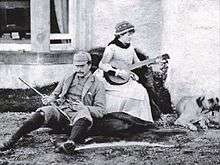
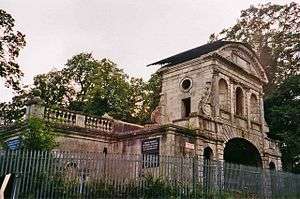
It was then given by King William III to William Bentinck, 1st Earl of Portland and descended in that family until sold in 1762 by 3rd Duke of Portland to George Prescott, a merchant and MP. Prescott built a Georgian style mansion known as The Cedars about a mile to the west of the original palace.
The new house passed from the Prescott family to the Meux family of Meux's Brewery fame in about 1820, and they made extensive alterations and added extensions during the nineteenth century. These included a remodelled entrance based on Sir Christopher Wren's Temple Bar, which had been dismantled and stored in a yard at Farringdon Road. In 1888, it caught the eye of the beautiful (painted by Whistler) and eccentric Lady Meux (formerly a banjo-playing barmaid named Val); the gateway was purchased from the City of London and the 400 tons of stone was transported by horse-drawn carts to the park, where it was carefully rebuilt at a cost of £10,000.[17] Lady Val Meux often entertained in the gateway's upper chamber; guests included King Edward VII and Winston Churchill.[18]
Later history
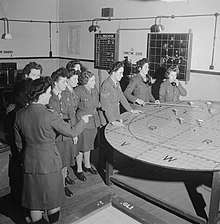

When Sir Hedworth Lambton, the commander of the Naval Brigade at Ladysmith, returned to England, he called on Lady Meux at Theobalds to recount his adventures. She was so taken with him that she made him the chief beneficiary of her will, on condition that he change his surname to Meux (she was without direct heirs, and had been snubbed by her husband's family). When she died on 20 December 1910, he willingly changed his name by Royal Warrant,[19] and inherited the Hertfordshire estate and a substantial interest in the Meux Brewery.[20]
In 1921 part of the park, the site of the demolished Elizabethan mansion, was given to the town of Cheshunt by Meux and a public park, The Cedars, created. After his death in 1929, the house was a hotel for some years. During World War II, the house was used by the Royal Artillery and then by the Metropolitan Police as a riding school. Renamed to Theobalds House, in 1955 it became a secondary school and after 1969, an adult education centre. In the 1990s it was refurbished for use as a commercial conference centre and later converted to its current (2015) status as the Theobalds Park Hotel in the De Vere Venues chain.[21] The Temple Bar had remained in the hands of the trustees of the Meux family estate and despite its status as a Scheduled Ancient Monument, had lapsed into decay. After a long campaign, it was decided to return it to the City in 2001. The arch was again dismantled, and was reconstructed on a site next to St Paul’s Cathedral. The project was completed in November 2004,[22] and a commemorative plaque was placed in Theobalds Park.[23]
References
- Emily Cole, 'Theobalds, Hertfordshire: The Plan and Interiors of an Elizabethan Country House', Architectural History, 60 (2017), pp. 71-117.
- John Summerson, 'The Building of Theobalds, 1564-1585', Archaeologia, 97 (1959), pp. 107-126
- "Hotels in Hertfordshire | Meeting Rooms | Theobalds Estate Cheshunt". www.phcompany.com. Retrieved 29 October 2016.
- Historic England. "THEOBALDS PARK COLLEGE (1348341)". National Heritage List for England. Retrieved 27 December 2015.
- "'Theobalds', The Environs of London: volume 4: Counties of Herts, Essex & Kent (1796), pp. 29-39".
- Summerson (1959), p. 107.
- Loades, D., The Cecils: Privilege and Power behind the throne (The National Archives, 2007). pp. 124-5.
- HMC Salisbury Hatfield: Addenda, vol. 13 (London, 1915), pp. 110-1, 228
- Summerson (1959), p. 113.
- Summerson (1959), p. 114, 122-3, pl. XXXI.
- William Murdin, Collection of state papers left by William Cecill lord Burghley (London, 1759), pp. 375-8
- "'Theobalds', The Environs of London: volume 4: Counties of Herts, Essex & Kent".
- HMC Salisbury Hatfield, vol. 15 (London, 1930), p. 71.
- HMC Salisbury Hatfield, vol. 17 (London, 1938), p. 214-5.
- Henry Harington, Nugae Antiquae, vol. 1 (London, 1804), pp. 348-351
- G. Dyfnallt Owen & Sonia P. Anderson, HMC 75 Downshire, vol. 6 (London, 1995), p. 521 no. 1123.
- Frederick Madden, Issues of the Exchequer: James I (London, 1836), pp. 225, 288-9.
- Cole, 'Theobalds' (2017), p. 106.
- Historic England. "Temple Bar (1393844)". National Heritage List for England. Retrieved 18 April 2012.
- "History of Temple Bar | Temple Bar Gateway". Thetemplebar.info. 10 November 2004. Retrieved 10 August 2013.
- "- Person Page 2748". Retrieved 20 December 2014.
- "History In Portsmouth". Retrieved 20 December 2014.
- "Theobalds Park | Temple Bar Gateway". Thetemplebar.info. Archived from the original on 14 January 2011. Retrieved 10 August 2013.
- "The Project | Temple Bar Gateway". Thetemplebar.info. Archived from the original on 3 August 2010. Retrieved 10 August 2013.
- "Commemorative Plaque | Temple Bar Gateway". Thetemplebar.info. Archived from the original on 3 August 2010. Retrieved 10 August 2013.
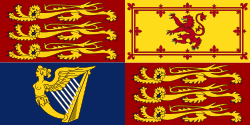
.svg.png)